Regional Pollen Calendars
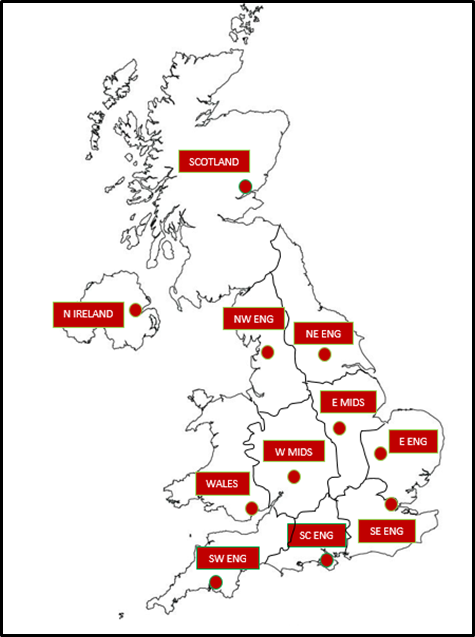 Map of pollen forecast regions and main pollen monitoring station location, per region (red dots).
Map of pollen forecast regions and main pollen monitoring station location, per region (red dots).
The pollen forecasting regions include Scotland, Northern Ireland, Northwest England, Northeast England, West-Midlands, East-Midlands, Wales, East of England, Southeast England, Southcentral England and Southwest England. Download all of the regional pollen calendars and seasonal statistics.
Each pollen calendar ranges from:
- Light Green - Earliest to latest pollen appearance, low risk
- Darker Green - average pollen season duration
- Blue - Phase when high counts can occur
- Purple - Phase when very high counts can occur.
Scotland

Hazel pollen occurs in low amounts from January to March (data not available for calendar).
Alder pollen range early February to mid-May. Risk is usually low.
Ash pollen range early March to early June. Risk is usually low.
Birch pollen range late March to mid-June. High risk possible from early April to mid-May.
Oak pollen range mid-April to late June. Risk is usually low.
Grass pollen range early April to early September. High risk possible from early June to early August. Peak period with occasional very high risk from mid-June to mid-July.
Nettle family pollen range May to September. Peak
For further information on the averages for onset and end of season, first high risk day average number of high risk days and total catch in Scotland a PDF is available.
Northern Ireland

Hazel and alder pollen occur from January to March (data not available for calendar).
Ash pollen range early March to end of June. Risk is usually low.
Birch pollen range mid-March to early June. High risk possible from start of April to mid-May.
Oak pollen range early April to mid-July. Risk is usually low.
Grass pollen range April to September. High risk possible from mid-May to early August. Peak period with occasional very high risk from early June to mid-July.
Nettle family pollen range mid-April to September. Peak period with risk of high counts from early June to early September.
For further information on the averages for onset and end of season, first high risk day average number of high risk days and total catch in Northern Ireland a PDF is available.
Northwest England
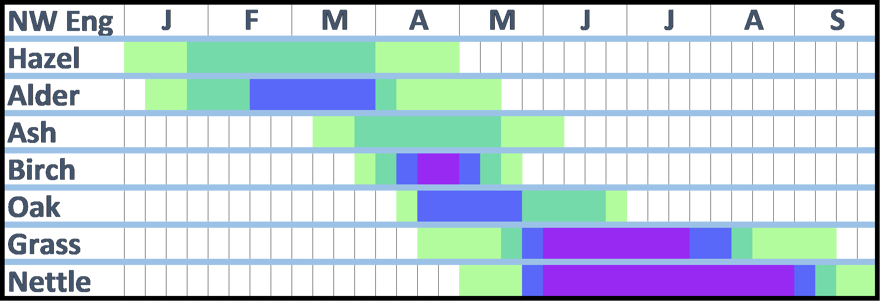
Hazel pollen range January to April. Risk for hazel is usually low.
Alder range early January to mid-May. Peak with risk of high from mid-February to end of March.
Ash pollen range early March to early June. Risk is usually low.
Birch pollen range late March to mid-May. High risk possible from start of April to early May.
Oak pollen range early April to late June. High risk possible early April to mid-May.
Grass pollen range April to September. High risk possible from mid-May to early August. Peak period with occasional very high risk from early June to mid-July.
Nettle family pollen range mid-April to mid-September. Peak period with high risk late May to early September.
For further information on the averages for onset and end of season, first high risk day average number of high risk days and total catch in Northwest England a PDF is available.
Northeast England

Hazel and alder pollen occur from January to early April. Risk for hazel is usually low. Peak with risk of high from mid-February to end of March (data not available for calendar).
Ash pollen range mid-March to mid-June. Risk is usually low.
Birch pollen range late March to mid-June. High risk possible from start of April to early May.
Oak pollen range late March to late June. High risk possible mid-April to late May.
Grass pollen range mid-April to end of August. High risk June to July. Peak period with occasional very high risk from early June to mid-July.
Nettle family pollen range mid-April to early September. Peak period with high risk June to August.
For further information on the averages for onset and end of season, first high risk day average number of high risk days and total catch in Northeast England a PDF is available.
Wales

Hazel and alder pollen occur from January to late March. Risk for hazel is usually low. Peak with risk of high from mid-February to end of March (data not available for calendar).
Ash pollen range early March to early June. High risk possible from late March to late April.
Birch pollen range mid-March to early June. High risk possible from late March to early May.
Oak pollen range start of April to late June. High risk possible mid-April to late May.
Grass pollen range start of April to early September. High risk late May to early August. Peak period with very high risk from early June to mid-July.
Nettle family pollen range May to mid-September. Peak period with high risk June to August.
For further information on the averages for onset and end of season, first high risk day average number of high risk days and total catch in Wales a PDF is available.
West Midlands
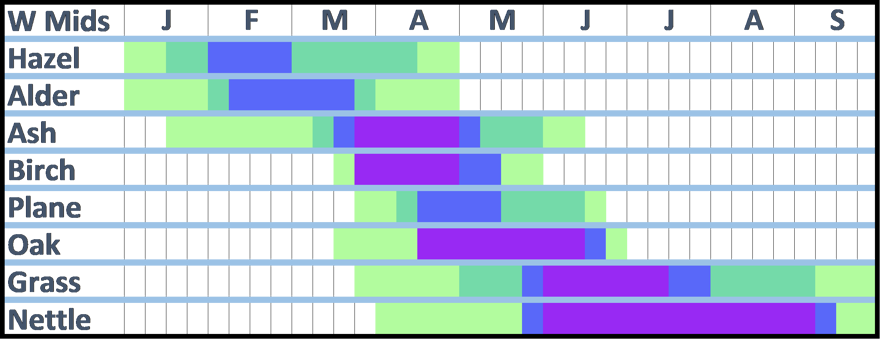
Hazel and alder pollen occur from January to April. Occasional high risk for hazel in February and high risk for alder from early February to late March.
Ash pollen range mid-January to mid-June. High risk possible from mid-March to early May.
Birch pollen range mid-March to end of May. High/very high risk possible from late March to mid-May.
Plane pollen range from late March to mid-June with peak risk mid-April to mid-May. (Tree located in towns and cities only).
Oak pollen range mid-March to late June. High risk possible mid-April to mid-June.
Grass pollen range late March to end of September. High risk late May to end of July. Peak period with very high risk from early June to mid-July.
Nettle family pollen range April to September. Peak period with high risk late May to late August.
For further information on the averages for onset and end of season, first high risk day average number of high risk days and total catch in the West Midlands a PDF is available.
East Midlands
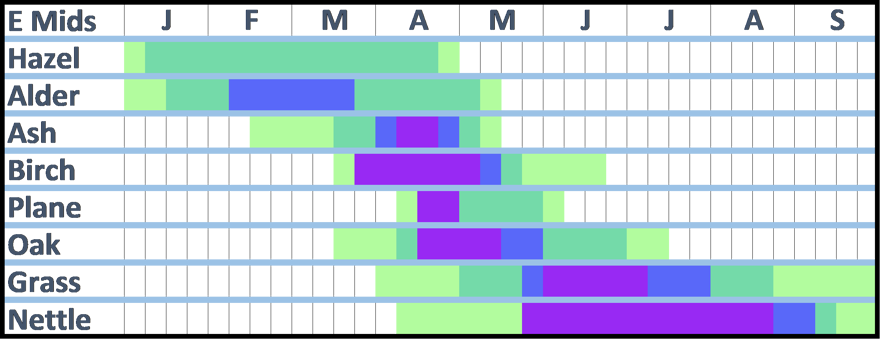
Hazel pollen range from January to April. Usually low risk for this type.
Alder pollen range from January to mid-May. High risk period from early February to late March.
Ash pollen range mid-February to mid-May. High risk possible during April.
Birch pollen range mid-March to mid-June. High/very high risk possible from late March to mid-May.
Plane pollen range from early April to early June with peak risk during April. (Tree located in towns and cities only).
Oak pollen range mid-March to early July. High risk possible mid-April to late May.
Grass pollen range April to end of September. High risk late May to end of July. Peak period with very high risk from early June to early July.
Nettle family pollen range April to September. Peak period with high risk late May to early September.
For further information on the averages for onset and end of season, first high risk day average number of high risk days and total catch in the East Midlands a PDF is available.
Southwest England
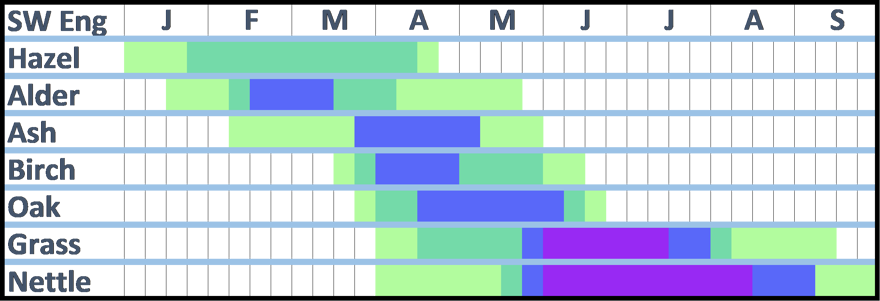
Hazel pollen occur from January to mid-April. Risk for hazel is usually low.
Alder pollen occur from mid-January to mid-May with high risk period mid-February to mid-March.
Ash pollen range mid-February to end of May. High risk possible during April.
Birch pollen range mid-March to mid-June. High risk possible from late March to early May.
Oak pollen range mid-March to mid-June. High risk possible mid-April to early June.
Grass pollen range start of April to mid-September. High risk late May to end of July. Peak period with very high risk from early June to mid-July.
Nettle family pollen range April to September. Peak period with high risk late May to early September.
For further information on the averages for onset and end of season, first high risk day average number of high risk days and total catch for Southwest England a PDF is available.
South Central England

Hazel and alder pollen occur from January to April. Occasional high risk for hazel in February and high risk for alder from early February to late March. (Data not available for calendar).
Ash pollen range mid-March to end of May. High risk possible from late March to early May.
Birch pollen range early March to mid-June. High risk possible from beginning of April to early May.
Oak pollen range early April to mid-June. High risk possible mid-April to late May.
Grass pollen range early May to mid-September. High risk late May to end of July. Peak period with very high risk from start of June to mid-July.
Nettle family pollen range early April to late September. Peak period with high risk mid-May to end of August.
For further information on the averages for onset and end of season, first high risk day average number of high risk days and total catch for South Central England a PDF is available.
East of England

Hazel and alder pollen occur from January to April. Occasional high risk for hazel in February and high risk for alder from early February to late March. (Data not available for calendar).
Ash pollen range mid-March to end of May. High risk possible from late March to early May.
Birch pollen range mid-March to mid-June. High risk possible from late March to mid May.
Plane pollen range April to June. High risk possible from mid-April to mid-May.
Oak pollen range early April to late June. High risk possible mid-April to mid-June.
Grass pollen range April to September. High risk late May to third week of July. Peak period with very high risk from start of June to mid-July.
Nettle family pollen range late March to late September. Peak period with high risk late May to early September.
For further information on the averages for onset and end of season, first high risk day average number of high risk days and total catch in the East of England a PDF is available.
Southeast England

Hazel and alder pollen occur from January to April. Occasional high risk for hazel in February and high risk for alder from early February to late March. (Data not available for calendar).
Ash pollen range March to end of May. High risk possible from late March to early May.
Birch pollen range March to mid-June. High risk possible from mid-March to mid-May.
Plane pollen range mid-March to June. High risk possible from early April to late May.
Oak pollen range mid-March to mid-June. High risk possible mid-April to end of May.
Grass pollen range mid-March to late September. High risk late May to third week of July. Peak period with very high risk from late May to mid-July.
Nettle family pollen range late March to late September. Peak period with high risk late May to early September.
For further information on the averages for onset and end of season, first high risk day average number of high risk days and total catch in Southeast England a PDF is available.
Data analysed for 10 years (2003 to 2014), for main UK pollen allergens (averages).
Reference: Adams-Groom et al. 2020. Regional calendars and seasonal statistics for the United Kingdom’s main pollen allergens. Allergy.
Generalised Pollen Calendar
Below is a generalised pollen calendar to show when the main allergenic plants are in flower. The timing will differ from south to north and also west to east and with height above sea level. The exact timing and severity of the pollen seasons will differ from year to year depending on the weather and on biological factors.
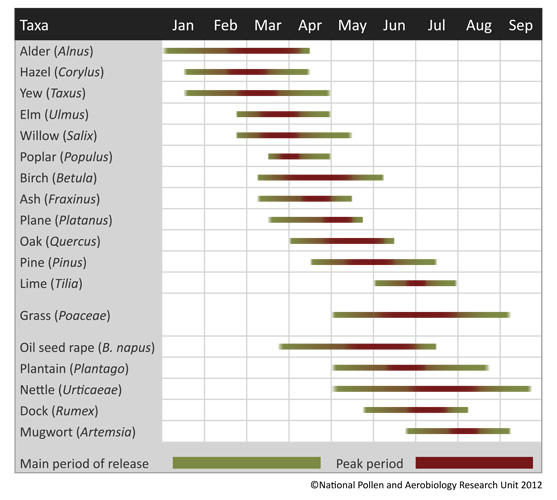
Low Pollen Holiday Destinations
Though it is impossible to completely avoid pollen there are lower pollen holiday destinations that vary depending on the time of year.
Low tree pollen holiday destinations
Low grass pollen holiday destinations